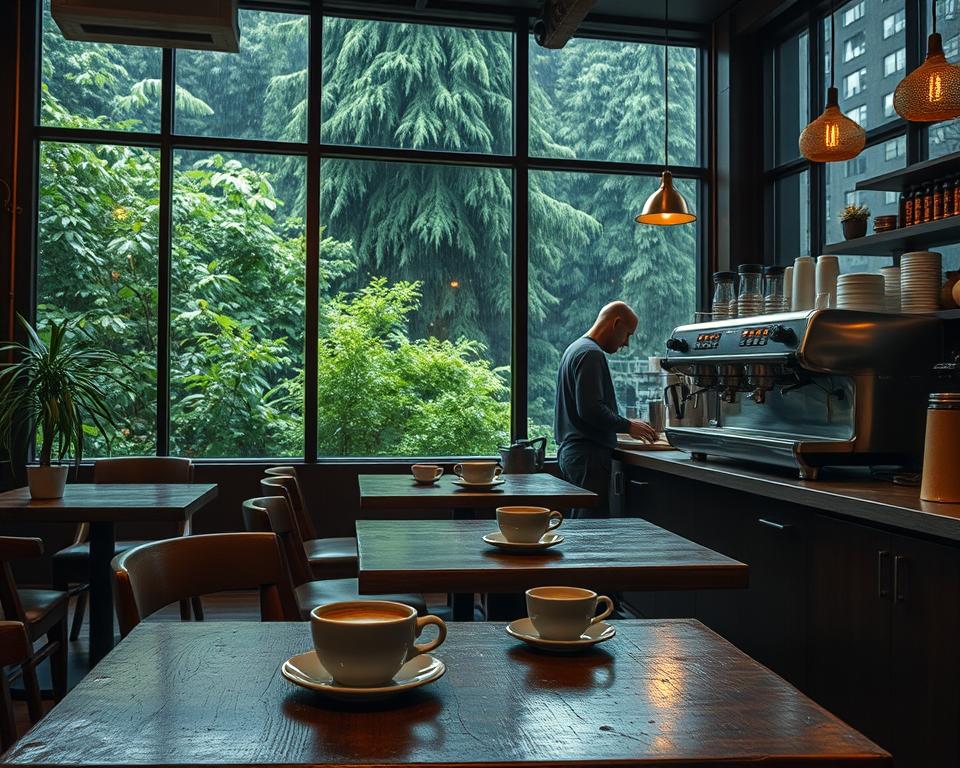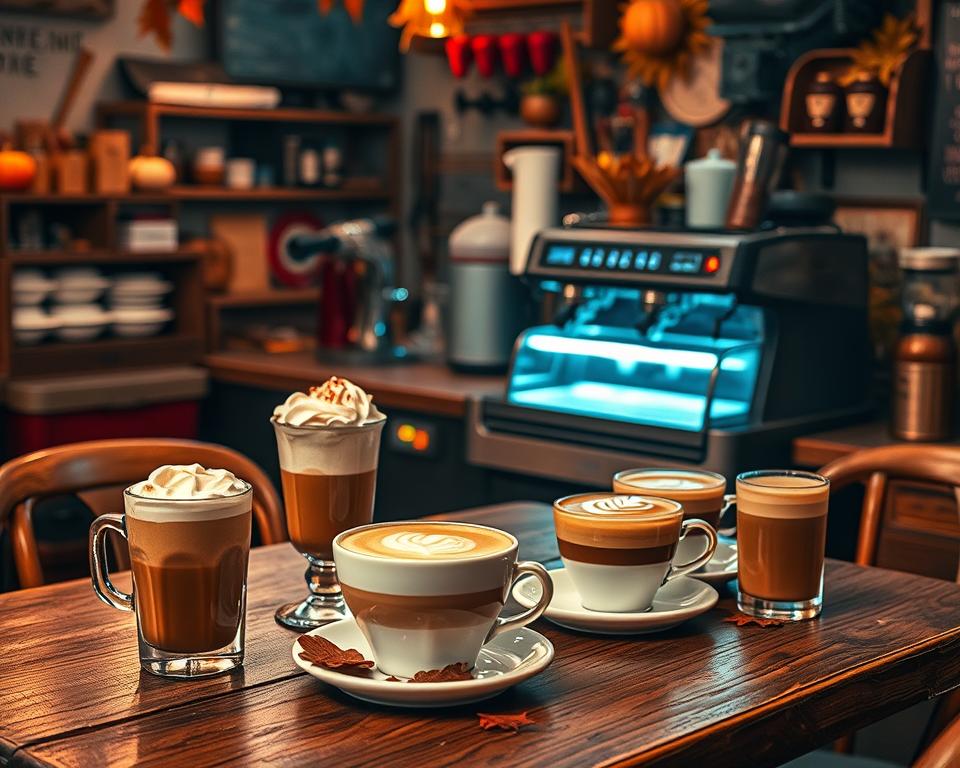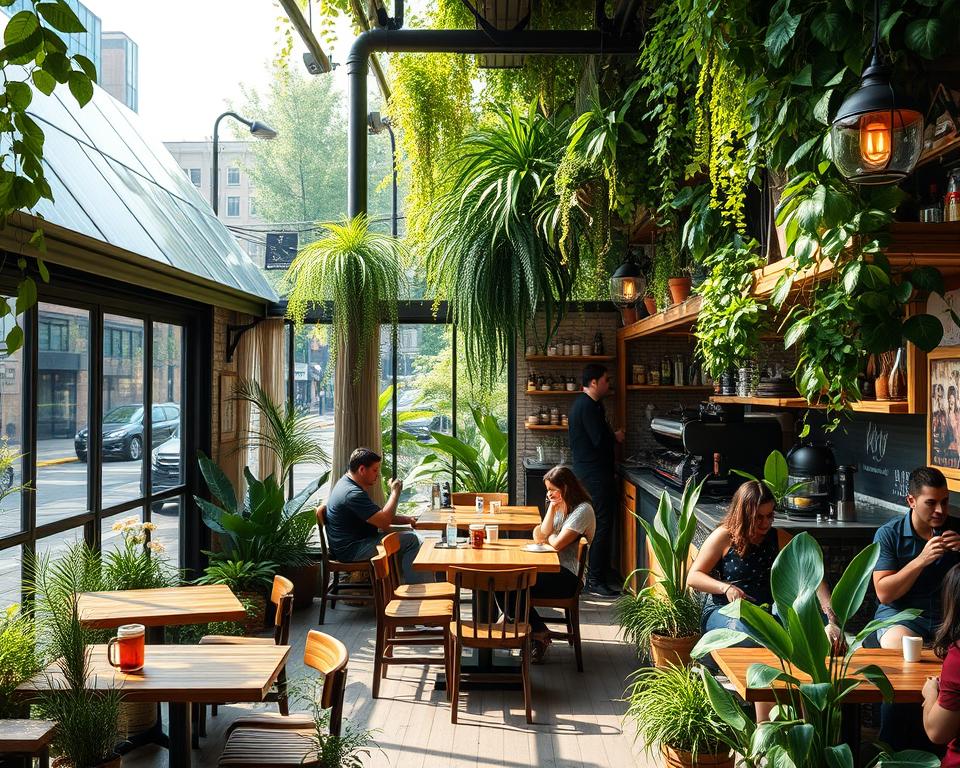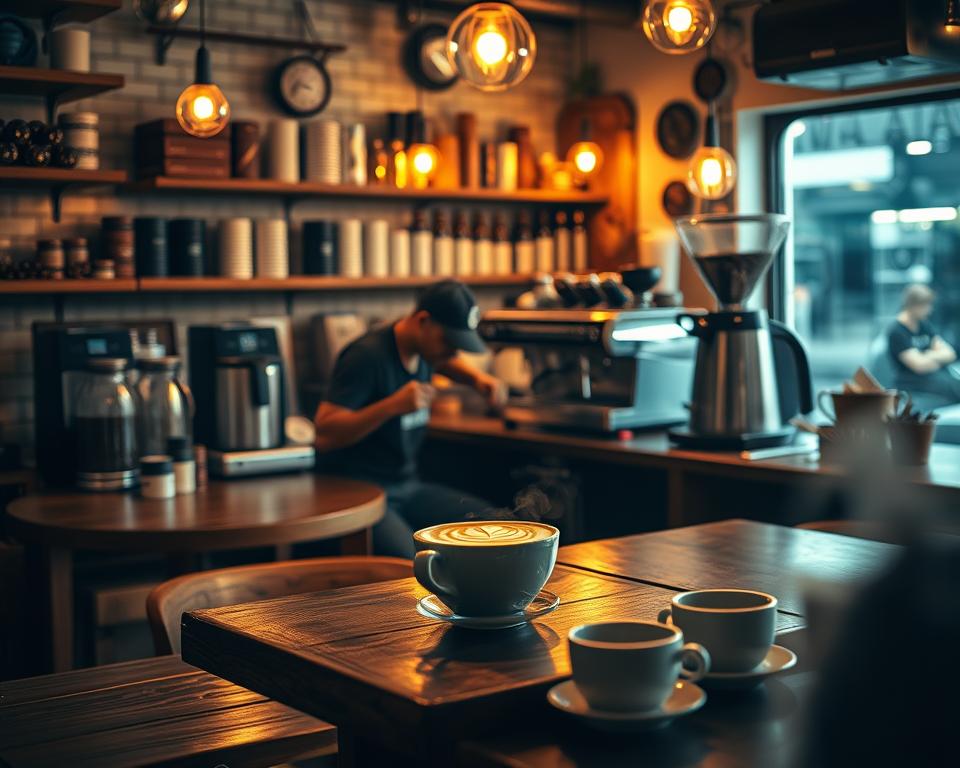The global coffee scene is vibrant and diverse, just like its host cities. By coffee exploration journey, it becomes clear that coffee isn’t just a drink. It’s a reflection of culture, traditions, and social habits.
Exploring coffee rituals in different cities is eye-opening. Italy, for example, is famous for its espresso rituals deeply embedded in their lifestyle. In Greece, locals enjoy Greek coffee slowly in beautiful cafés by the sea. Ethiopia, where coffee comes from, celebrates it with a detailed ceremony. Each city adds a unique taste to the world’s coffee scene.
In North America, every street from New York to Seattle boasts a unique coffee shop. Europe values its espresso traditions, especially in Italy. Meanwhile, Central and South America offer deep coffee experiences. You can explore Colombia’s coffee farms or enjoy Brazil’s famous Cafézinho.
This article takes you to different cities to see coffee’s role in daily life and culture. From Shanghai’s new coffee trends to Europe and the Americas’ old practices, each city tells its story. Come along on this adventure to uncover the rich and varied coffee world.
North America: From Seattle to New York
Seattle and New York are the hearts of North America’s coffee culture. Both cities are known for their love of coffee, offering unique and diverse flavors. They highlight the best of vibrant coffee scenes.
Seattle’s Coffee Scene
Seattle is famous for its coffee, having over 17,000 Starbucks stores nationwide. It’s filled with coffee shops that show its rich coffee history. Starbucks started here, highlighting its importance in coffee culture. The city’s coffee shops showcase many innovative brews.
In Seattle, local, family-owned coffee shops are everywhere. They capture the city’s essence. It’s more than just getting caffeine; it’s about valuing the art and history of coffee.
New York City’s Bustling Cafés
New York City’s cafés match its fast, energetic lifestyle, unlike Seattle’s calm vibe. These cafés are perfect for the city’s quick pace, offering speedy, quality coffee. Manhattan is full of stylish, modern coffee spots always full of life.
New York’s cafés have coffee from traditional to innovative styles. This mix lets coffee lovers find their favorite.
Seattle’s coffee shops and New York’s cafés both celebrate North America’s coffee culture. They offer unique experiences for coffee fans. From Seattle’s relaxed coffees to New York’s lively spots, they show what makes this culture special.
Europe: Sipping Espresso in Italy and Beyond
Our journey starts in Italy, a place that masters espresso. Here, espresso is part of everyday life, celebrated for its deep flavor. Italians take pride in their coffee culture. They love their quick ‘nero’ espresso shots. Coffee lovers should visit Illy’s Università del Caffè in Trieste. This city loves coffee so much, locals drink double the Italian average.
Italy’s Espresso Rituals
In Italy, espresso is deep in tradition. It started in Venice and now shapes the country. Espresso came in the late 1800s and changed coffee culture. Illy focuses on quality Arabica beans. Yet, they once had to use Robusta. Italian baristas train hard. They make espressos and cappuccinos with care, showing Italy’s coffee passion.
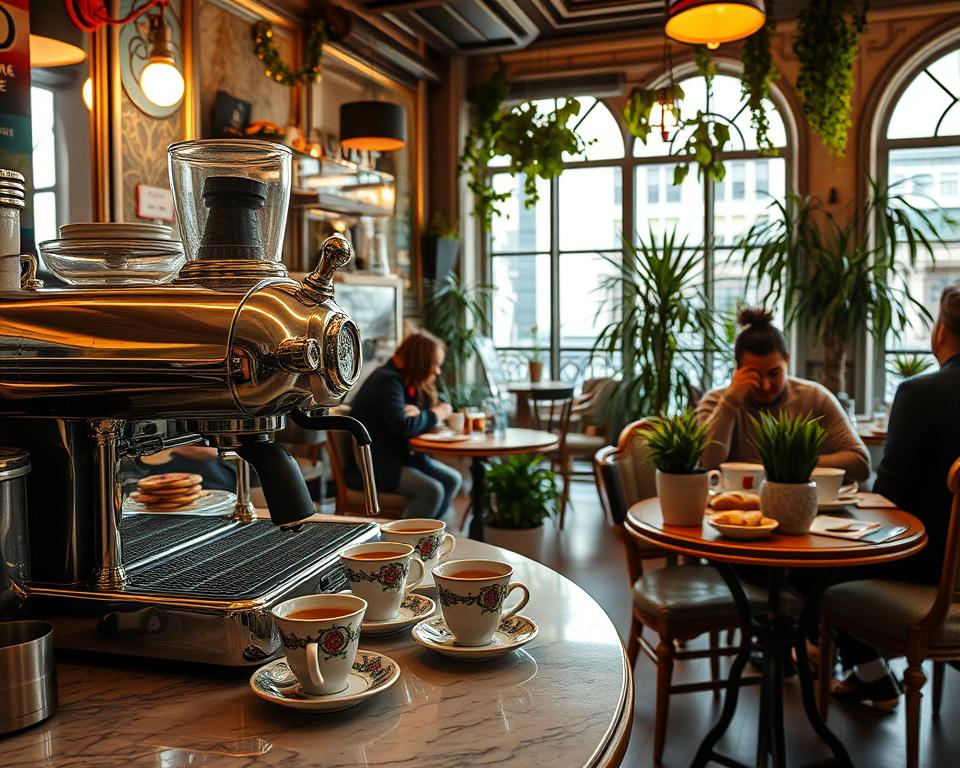
Turkish Coffee in Greece
In Greece, coffee means Turkish brew and is for socializing. It’s savored slowly, often during long chats. Served with grounds, it’s thick and comes with water. Greek cafés offer a nostalgic feel, linking to the tradition of Greek coffee. Each cup is a trip through history.
For a special coffee twist, check out this perfect recipe for coffee enthusiasts.
café culture in different cities
The journey to explore local coffee cultures shows a rich diversity. I’ve seen many differences and similarities in my travels. For example, in the U.S., drive-throughs are common for quick service. In contrast, Germany has fewer drive-throughs, mainly along highways.
In Germany, sustainability is big in cafés. Customers often use mugs, helping the environment. In the U.S., however, single-use cups are more common. With more people working remotely, cafés have become key places for work and relaxation. They offer free Wi-Fi and comfortable seats, meeting various needs.
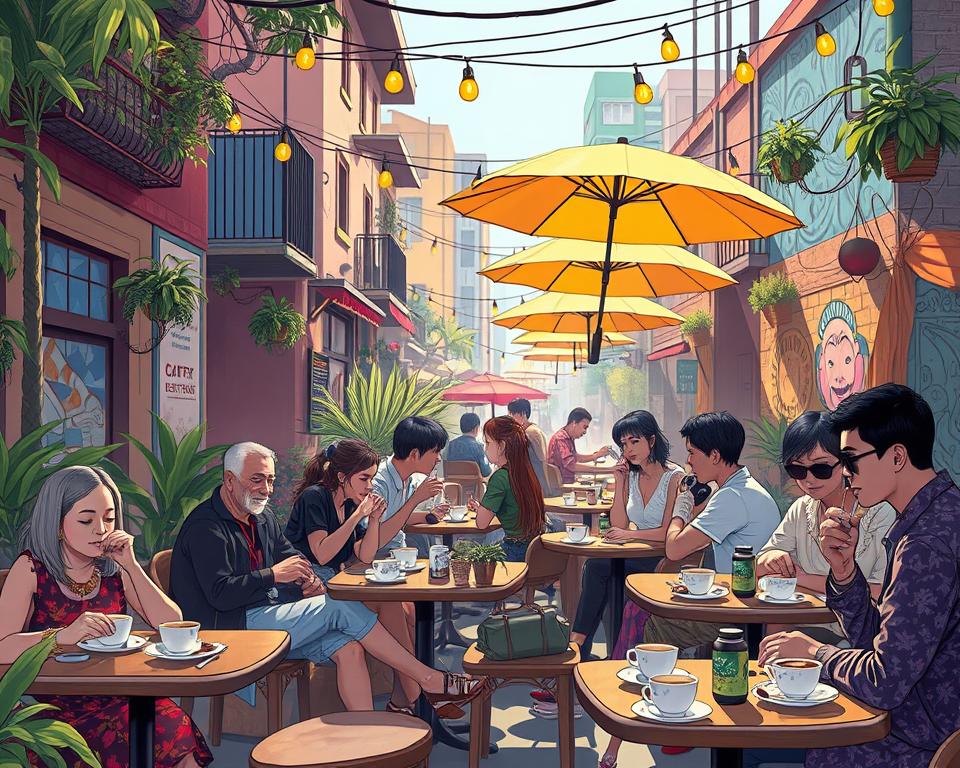
Cities like Paris, Vienna, and New York turned cafés into social spots in the 20th century. Starbucks in Seattle started a trend in 1971. It made cafés a ‘third place’ for people worldwide. Now, places like Norwich offer diverse café experiences for hanging out, working, or just relaxing. The variety in café culture shows in my travel observations.
In the US, cafés offer many flavored syrups, like lavender and blackberry. German cafés prefer simpler, traditional coffee. The choice of milk also varies. In the US, there’s almond, soy, and coconut milk. German cafés usually have cow milk and oat milk. Tipping also differs. In the US, tips of 15-20% are common. In Germany, tipping is not as common, usually just rounding up.
Every city has its unique coffee culture. From quick espresso shots in Italy to drive-throughs in the U.S. Afternoon coffee in Nablus shows each place’s unique traditions. The specialty coffee trend highlights this global connection. High-quality beans unite diverse cultures in their coffee love.
For more on North America’s coffee scenes, see more insights here. The coffee industry is huge, employing millions. Cafés are key for meeting friends, informal meetings, or relaxing, playing a big part in our lives.
Central and South America: Latin America’s Coffee Legacy
The coffee heritage in Central and South America is both rich and diverse. It shows the deep bond between coffee and Latin American culture. From Colombia’s famous Arabica beans to Brazil’s social cafézinho tradition, and Puerto Rico’s unique café con leche, each experience shares a special look into the region’s coffee culture.
Colombian Coffee Farms
Colombian coffee is known worldwide for its high quality, thanks to the Arabica beans. These beans grow in Colombia’s Coffee Triangle, a UNESCO-listed region. The area is famed for its fertile soil and great farming conditions in places like Caldas, Quindío, and Pereira. The growers in Colombia use traditional methods to bring out the best in the beans. This careful process results in Tinto, Colombia’s famous black coffee, which reflects the country’s daily life and socializing.
Brazil’s Cafézinho
The Brazilian cafézinho is more than a sweet black coffee; it’s a cultural icon. It’s a sign of hospitality, shared among loved ones as a warm gesture. The tradition of cafézinho is a big part of Brazil’s culture, showing how coffee helps forge and strengthen bonds. Brazil is one of the top coffee producers and its love for coffee shines through this beloved daily custom. It spotlights the importance of coffee traditions in Latin America.
Puerto Rico’s Café Con Leche
Puerto Rican coffee, especially café con leche, is a unique coffee experience. It’s known for its strong taste, blending intense coffee with steamed milk. This creates a creamy and luxurious drink, enjoyed any time of day in Puerto Rico. This coffee tradition shows the lasting love for coffee in Latin America. It captures the spirit of community and relaxation that coffee brings.
How Do Community Events Influence Café Culture in Different Cities?
Community events play a crucial role in shaping café culture across various cities. Local coffee shop happenings, such as art shows, live music, or book readings, create vibrant social hubs. These events encourage residents to gather, fostering connections that enhance the unique atmosphere and identity of each café.
Conclusion
Starting our global coffee journey has shown us the diverse coffee cultures around the world. We’ve seen the busy cafes in North America and Europe. We’ve also discovered the deep coffee traditions in Central and South America. Coffee is more than a beverage; it’s a symbol that unites people, encourages friendships, and celebrates the local coffee scene in its own special way.
On our caffeine adventure, we learned that the first coffee shop, Kiva Han, opened in Istanbul in 1475. It started the trend of cafes as places to meet and talk. By the 17th century, enjoying coffee outside in places like Vienna became a part of everyday life. Cities like Paris and Rome still honor this tradition today, attracting artists, thinkers, and locals.
In the Americas, coffee shops have become spots for community and creativity. They spark cultural and intellectual conversations. In New York City and San Francisco, cafes are lively places that bring people together. In Asia, Japan, South Korea, and Vietnam mix old brewing methods with modern styles. This makes the coffee experience better for both locals and tourists.
In the end, our global coffee journey teaches us one important lesson: cafes create a welcoming environment. They’re perfect for chatting, relaxing, and making friends. Whether it’s sipping traditional Turkish coffee, enjoying an Italian espresso, or trying Vietnamese egg coffee, each visit to a cafe is special. We get to stop for a moment, connect with others, and learn more about the amazing world of coffee. Let’s keep enjoying our coffee moments and discovering new cafe cultures on our journey.
FAQ
What defines café culture?
Café culture reflects different traditions and social rituals linked to coffee worldwide. It’s more than a drink choice. It’s a way to see how communities interact and live in various places.
How is Seattle’s coffee scene unique?
Seattle is a top spot for coffee lovers, with special brews everywhere. This city thrives on coffee’s rich flavors. This variety speaks to Seattle’s spirit of innovation and connection to coffee.
What makes New York City’s coffee culture distinct?
NYC’s coffee scene mirrors its fast life. Cafés buzz with energy, offering a range of coffees. This makes the city a favorite among coffee fans.
How is Italy’s espresso culture different from others?
In Italy, espresso is a daily tradition, rich in flavor and history. It symbolizes Italian culture, focusing on high quality and tradition.
What is the significance of Turkish coffee in Greece?
Turkish coffee is a key part of Greece’s culture. Greek cafés have breathtaking views, linking people to coffee’s historic role and communal rituals.
How does café culture differ across global cities?
Café culture changes a lot from city to city. From quick drinks in busy cities to relaxed sipping in small towns, local habits and social factors influence the coffee scene. This makes each place’s café culture unique.
What are the key characteristics of Colombian coffee farms?
Colombian coffee farms are famous for exceptional Arabica beans. The daily Tinto ritual shows Colombia’s strong coffee bond and heritage.
What is Brazil’s cafézinho and why is it important?
Brazil’s cafézinho is a sweet black coffee, important for socializing. It displays Brazilian warmth and the joy of sharing coffee moments.
How does Puerto Rico’s café con leche represent its culture?
Café con leche in Puerto Rico showcases its rich coffee culture. This beloved drink is central to social life and cultural traditions.
Why is exploring café culture globally significant?
Studying café culture worldwide shows us coffee’s power to connect different cultures. Every region offers special stories and experiences, enriching our global coffee understanding.

